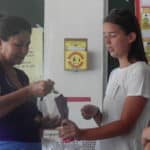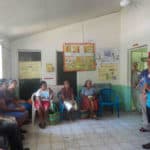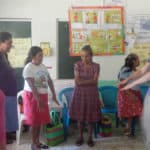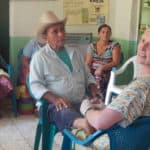Laura and I do not depend on stocking up on food and household supplies in Concepción. There is a market on Saturdays in Concepción where we can find some of what we need. The items are always more expensive, and it is not always clear just how fresh the fruits and vegetables are. The pulperias (Mom and Pop supply stores) may, or may not have fruits and vegetables during the week, but they certainly don’t look very appetizing by Wednesday or Thursday. Other supplies’ availability is at best a crap shoot and the quality is questionable. It is just hard to get anything down to the Frontera. We’re simply too far away. On one occasion we were looking for a small chain and padlock to secure a cabinet where we store a laptop at the clinic. I imagine that on Family Fued, the survey answers to the question, “Items found at a hardware store,” would likely include a chain and a padlock. Still, at the two retail places purporting to be hardware stores, we couldn’t find either. We ended up getting them in La Esperanza, where we end up buying almost all of our supplies.

Still, there is one thing here that is as ubiquitous as geckos. Snacks: sugar, salt, caffeine, synthetically contrived carbohydrates, and that orangey, sticky substance that stains your fingers and pretends to be cheese. Every pulperia stocks a plethora of these processed, plastic-packaged, brilliantly marketed, nutritionally challenged, faux food products. Coke, Pepsi, sports drinks, energy drinks, chips of every texture, flavor, and color, line the shelves. The evidence of their abundant presence is not confined to the pulperias. Their non-biodegradable containers litter roads, walkways, hills, and homes, even scattered along the pathways to the most remote villages. We have no landfills here, no recycling to speak off, and no understanding of how this stuff so completely debases life. It pollutes our bodies when it’s consumed, our land when it is discarded, our air when it is burned, and our community pride when it invades and conquers all viable development. It thrives here, much like weeds in an untended garden, and like weeds, chokes life and leeches the nutrients from the environment.
According to a Nielsen report, snack sales in Latin America ($30 billion) increased by 9% from 2013 to 2014 (http://www.nielsen.com/us/en/press-room/2014/global-snack-food-sales-reach-374-billion-annually.html, 9/30/2014). If obesity presents an epidemic crisis in the US, it’s right around the corner here. Diabetes, hypertension, cardiovascular disease, and other chronic, debilitating diseases follow behind the wholesalers’ snack vans that seem to have no problem reaching the Frontera. We’re in the middle of a drought. Water is as precious as gold here, but carbonated beverages flow with ease. María Antoinette’s prescient remark echoes across the hills of Southern Intibucá, “Let them eat cake.”

Marti Kubik, PhD, RN, and Karin Larson, RN from the University of Minnesota, understand this incipient danger. They prepared their students, studying for their Masters in Nursing, to speak sensitively and authoritatively about it to the people they would meet in Santa Lucia on their recent brigade. They spoke at the elementary and high schools and at the clinics, arming their audience with knowledge. Knowledge is the only effective defense against the snack purveyors’ reliance on the lure of immediate, self-gratification: “It tastes good, and it curbs my hunger.” One student’s passion came from a personal empathy; having managed diabetes, this student spoke from the heart.
Laura and I met up with the brigade on Thursday. They were traveling to the small clinic in the village of Santa Teresa about an hour and a half’s winding drive along a typical mountain road. The schedule purported they would be giving a workshop to a small group of women in the pregnancy club. Upon arrival, however, the men and women present were clearly not anticipating the arrival of a child. It was the chronic disease club. Dr. Kubik took it in stride, reminding her students that flexibility is a necessary talent. Serendipitously, the students quickly readied themselves to present on the dangers of the snack culture.

Their presentation was as exceptionally flawless as it was engaging, and certainly no one would have known that they had come expecting to present on an entirely different subject. They first recognized how packed the room was, and thus had the sensitivity to present in teams of pairs rather than en masse. This sense of sensitivity and respect set the tone. Then someone showed a coke bottle, asking the audience to guess at how many teaspoons of sugar it contained. “Two, three, maybe four.” A sixteen ounce bottle typically contains eleven teaspoons of sugar. “Ugh, that’s disgusting!” as the participant fills the bottle with sugar. How does it even dissolve? Then, someone else presents a stack of empty bags of chips. We call them churros here, an innocuous, innocent word that draws up an image of a cute, panda bear. Someone reads the nutritional information. The first thing to notice is that in this tiny little bag containing less than a handful of crunchy things, the packaging claims there are three servings. Three servings cost five lempira (about $.23). Ralph Nader would have a field day debating the lack of truth in advertising. Then, they read the ingredients: the unpronounceable chemical compounds with fats, sugars, and salt. Everyone is laughing at the expense of the producers of poison. The curtain has been drawn back and the wizard is seen for who he truly is.
After the debunking, the discussions move to self care. Exercises bring the group to their feet and we’re all dancing and laughing. Then, before we dismiss the chronic disease club, everyone gets an individual check-up with blood pressures read and lungs and hearts listened to. A couple of feet are checked as foot care is critical for diabetics. Dr. Kubik is examining one woman. She proudly professes how faithful she is to her hygiene. Dr. Kubik exclaims, “I’ve never seen such well cared for feet! I would like to take you to the United States and present you as a model patient to the patients I see there.” True enough, most people want to be healthy.

It’s unfortunate that the force of consumerism blinds its benefactors to basic human dignity. There are other voices, though. These are the voices that respect human dignity. Thank you Minnesota for making it down to the Frontera.


